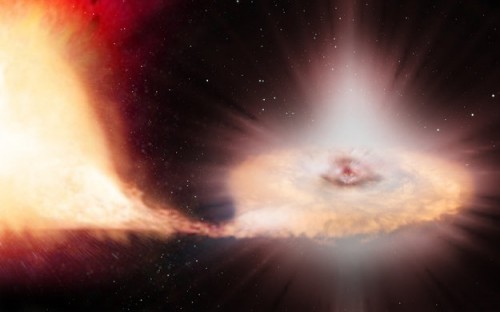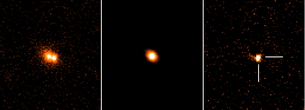According to the spectrum of the supernova, it is possible to see various elements that characterize a type Ia supernova such as iron, oxygen, calcium and sulfur. Thus, among other things, it can be determined that this is a supernova and not the eruption of a distant black hole in the center of the galaxy.
He participated in the preparation of the article Ben Nathaniel

On July 25, Gaia began its scientific work and since then it has been scanning the sky repeatedly so that it can detect changes in the brightness of stars and other bodies. On August 30, the Gaia crew noticed a sharp increase in the brightness of a galaxy and thus discovered the supernova now called Gaia14aaa.
According to the spectrum of the supernova, it is possible to see various elements that characterize a type Ia supernova such as iron, oxygen, calcium and sulfur. Thus, among other things, it can be determined that this is a supernova and not the eruption of a distant black hole in the center of the galaxy.
"This kind of repeat survey gives us the ability to study the changing nature of the sky," says Simon Hodgkin of the Astronomical Institute in Cambridge, UK.
Many sources in the sky are variable: some of these bodies form regular patterns, showing a cyclical increase in brightness, while others may undergo sudden changes.
light curve

When Gaia repeats the same segment of space again and again, we have the opportunity to observe thousands of "guest stars" on the celestial stage," added Dr. Hodgkin. "These ephemeral sources can serve as evidence for some of the most powerful phenomena in the universe, such as this supernova."
Dr. Hodgkin is a member of the Gaia science team, which includes astronomers from the University of Cambridge in the UK and the University of Warsaw, who are examining the probe's scans for unexpected changes.
"It didn't take long before we discovered the first anomaly in the form of a sudden peak in the light coming from a distant galaxy, which was discovered on August 30. The same galaxy appeared much dimmer when Gaia observed it one month earlier.”
"We immediately recognized that it was a supernova, but we needed clues to back up our claim," explains Lekoś Wirczykowski from the Warsaw University Astronomical Observatory.
Other astronomical events may resemble a distant supernova, for example a burst of light when some body is swallowed by a black hole at the center of a distant galaxy. However, in the case of Gaia14aaa, the position of the light point was slightly distant from the galaxy nucleus, which indicated a low probability of its connection with the central black hole.
Therefore the researchers sought further knowledge in the light of the star. Besides recording the position and brightness of the stars in the galaxy, Gaia also splits their light into the components of the spectrum. Gaia actually uses two prisms that look at the blue and red light frequencies to create a low-resolution spectrum that will allow astronomers to look for signatures of the various chemical components present in the light source.
In the spectrum of this source, we could see the presence of iron and other elements that we know are present in supernovae" says Nadia Belgordanova, PhD student at the Institute of Astronomy in Cambridge.
In addition, the blue part of the spectrum appears significantly brighter than the red part, as expected in a supernova. And not just any supernova, the astronomers suspect that it is a type Ia supernova, the explosion of a white dwarf trapped in a double star system with a companion star.
